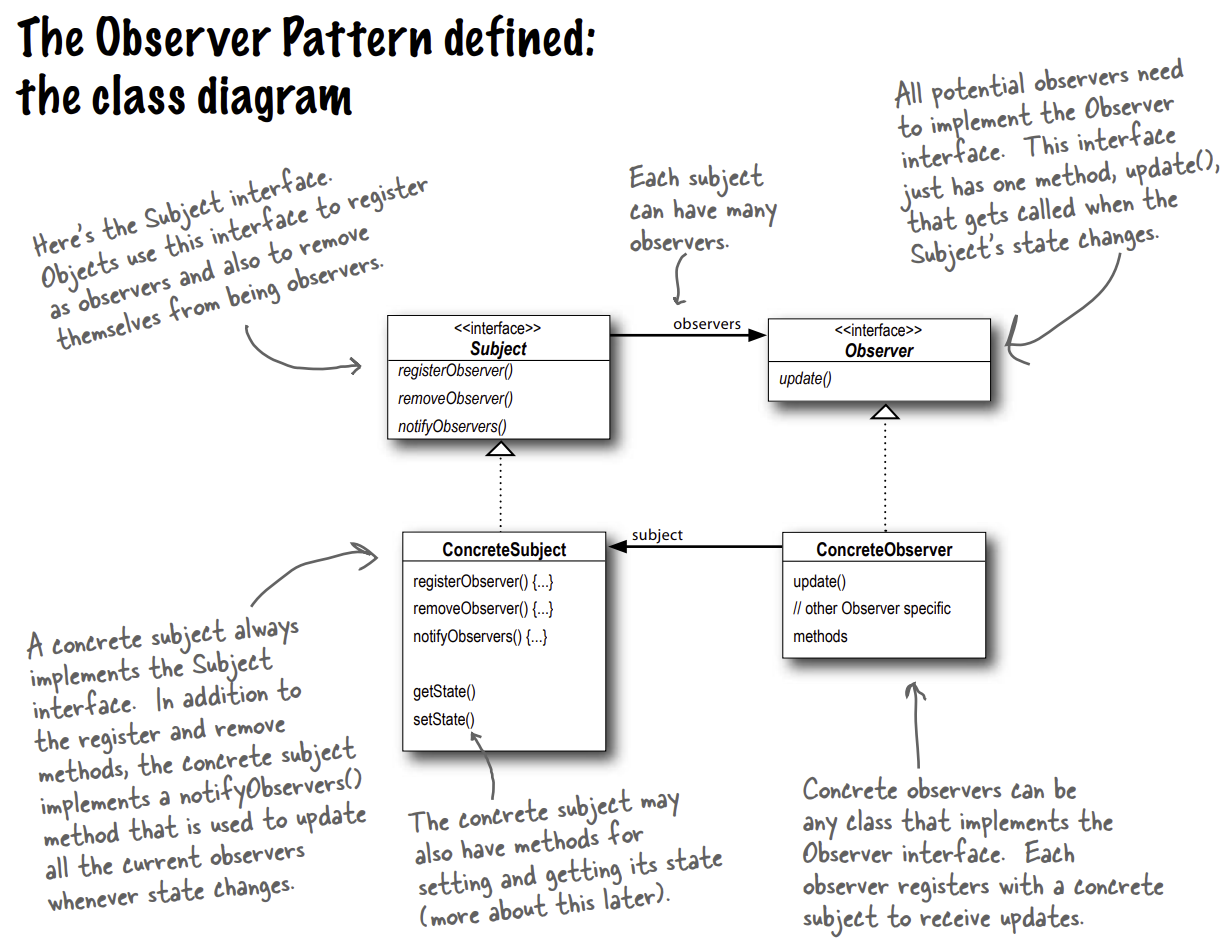The Observer Pattern defines a one-to-many dependency between objects so that when one object changes state, all of its dependents are notified and updated automatically.
The observer pattern consists of publishers and subscribers similar to a newspaper subscription, where the publisher is also known as subject or observable and the subscribers are called observers.
The observer pattern provides an object design where subjects and observers are loosely coupled because of the following reasons:
- The only thing the subject knows about an observer is that it implements a certain interface (the Observer interface).
- We can add new observers at any time.
- We never need to modify the subject to add new types of observers.
- We can reuse subjects or observers independently of each other.
- Changes to either the subject or an observer will not affect the other.
With the observer pattern it is possible to pull or push data from the observable whereas pull is considered more correct.
It is also important to note that you should not depend on a specific order of notification for your observers.

Here is the interface of a subject that a concrete subject class needs to implement in order to register, remove and notify observers.
public interface Subject {
public void registerObserver(Observer o);
public void removeObserver(Observer o);
public void notifyObservers();
}As an example for a concrete subject the following weather data class is given.
It has a member ArrayList<Observer> that stores the currently registered observers.
import java.util.*;
public class WeatherData implements Subject {
private ArrayList<Observer> observers;
private float temperature;
private float humidity;
private float pressure;
public WeatherData() {
observers = new ArrayList<Observer>();
}
public void registerObserver(Observer o) {
observers.add(o);
}
public void removeObserver(Observer o) {
int i = observers.indexOf(o);
if (i >= 0) {
observers.remove(i);
}
}
public void notifyObservers() {
for (Observer observer : observers) {
observer.update(temperature, humidity, pressure);
}
}
public void measurementsChanged() {
notifyObservers();
}
public void setMeasurements(float temperature, float humidity, float pressure) {
this.temperature = temperature;
this.humidity = humidity;
this.pressure = pressure;
measurementsChanged();
}
public float getTemperature() {
return temperature;
}
public float getHumidity() {
return humidity;
}
public float getPressure() {
return pressure;
}
}When the notifyObservers() function gets called, which happens when some data of
the subject changes, the subject knows how to inform the observers because they all
implement the same interface.
public interface Observer {
public void update(float temp, float humidity, float pressure);
}The observers that implement this interface know about the subject, which allows them
to register themselves to be kept informed. This can be seen in the following
example that also implements another interface DisplayElement.
public class CurrentConditionsDisplay implements Observer, DisplayElement {
private float temperature;
private float humidity;
private Subject weatherData;
public CurrentConditionsDisplay(Subject weatherData) {
this.weatherData = weatherData;
weatherData.registerObserver(this);
}
public void update(float temperature, float humidity, float pressure) {
this.temperature = temperature;
this.humidity = humidity;
display();
}
public void display() {
System.out.println("Current conditions: " + temperature
+ "F degrees and " + humidity + "% humidity");
}
}Another example of a observer implementation.
public class StatisticsDisplay implements Observer, DisplayElement {
private float maxTemp = 0.0f;
private float minTemp = 200;
private float tempSum= 0.0f;
private int numReadings;
private WeatherData weatherData;
public StatisticsDisplay(WeatherData weatherData) {
this.weatherData = weatherData;
weatherData.registerObserver(this);
}
public void update(float temp, float humidity, float pressure) {
tempSum += temp;
numReadings++;
if (temp > maxTemp) {
maxTemp = temp;
}
if (temp < minTemp) {
minTemp = temp;
}
display();
}
public void display() {
System.out.println("Avg/Max/Min temperature = " + (tempSum / numReadings)
+ "/" + maxTemp + "/" + minTemp);
}
}And the additional interface they use.
public interface DisplayElement {
public void display();
}The following main WeatherStation class shows the observer pattern in use.
public class WeatherStation {
public static void main(String[] args) {
WeatherData weatherData = new WeatherData();
CurrentConditionsDisplay currentDisplay =
new CurrentConditionsDisplay(weatherData);
StatisticsDisplay statisticsDisplay = new StatisticsDisplay(weatherData);
weatherData.setMeasurements(80, 65, 30.4f);
weatherData.setMeasurements(82, 70, 29.2f);
}
}Starting this application results in the following output.
$java WeatherStation
Current conditions: 80.0F degrees and 65.0% humidity
Avg/Max/Min temperature = 80.0/80.0/80.0
Current conditions: 82.0F degrees and 70.0% humidity
Avg/Max/Min temperature = 81.0/82.0/80.0
Comments